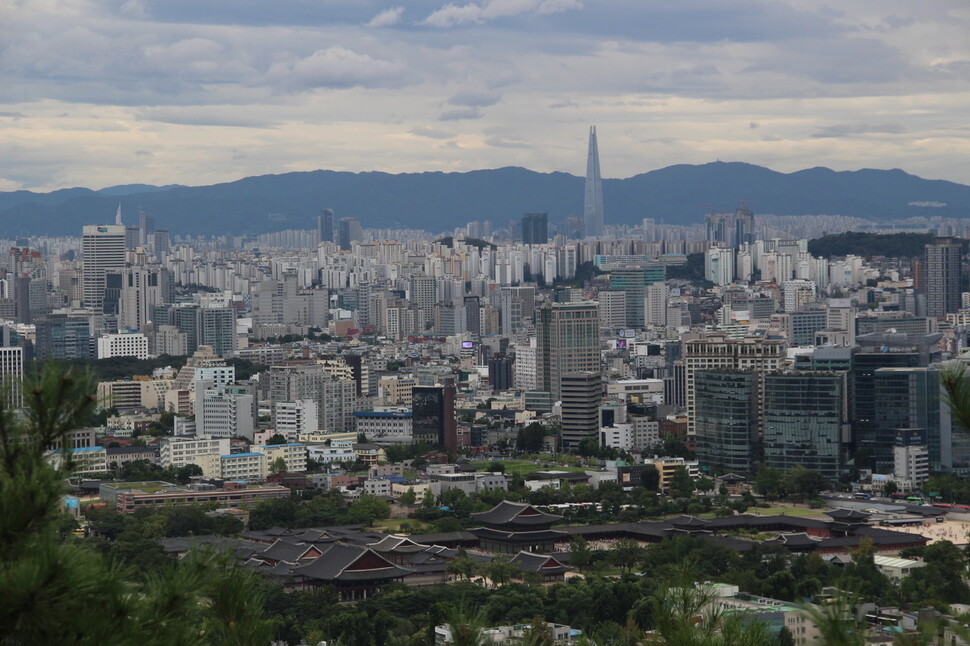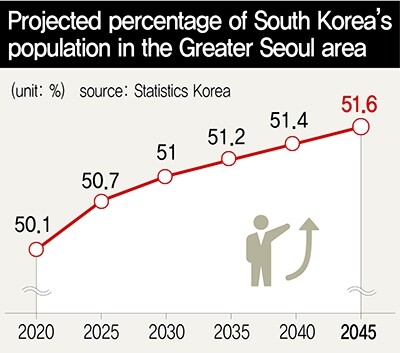hankyoreh
Links to other country sites 다른 나라 사이트 링크
More than 50% of population estimated to be concentrated in Greater Seoul

“The South Korean government will be pushing ahead more forcefully with balanced national development policies that are more advanced than those of the Roh Moo-hyun administration.”
South Korean President Moon Jae-in shared this message at a February 2018 ceremony at the Sejong Conventional Center in Sejong to proclaim a balanced national development vision and strategy. Seven months later in September, Lee Hae-chan, leader of the Democratic Party, announced in a speech as a National Assembly negotiation group representative that an additional 122 public institutions would be relocated outside of the Greater Seoul area – joining the 153 relocated to Sejong and 10 “innovation cities” during the Roh administration. But neither the administration nor the ruling party had yet come out with any more forceful balanced development policies than the Roh administration’s or plans for a second relocation of public institutions.

It has now emerged that the percentage of South Korea’s population living in the Greater Seoul area is set to cross the 50% mark for the first time in history around September of this year. It’s an increasingly extreme manifestation of a skewed phenomenon where over half of all South Koreans live in Seoul, Incheon, and Gyeonggi Province – which together represent just 11.8% of South Korea’ total area of 100,387 square kilometers. The issue is not only about population: the Greater Seoul area previously passed the 50% mark in terms of gross production in 2017. That percentage had previously been reduced from 49.5% in 2002 to 48.2% in 2011 through bold balanced development policies by the Roh administration, but the situation reversed itself under the later Lee Myung-bak and Park Geun-hye administrations as balanced development policies were halted and regulations on Greater Seoul were loosened.
“During the Roh Moo-hyun administration, vigorous balanced development policies were used as a way of bridging the gap between Greater Seoul and the provinces, but the effects have been diminishing as the balanced development policies of subsequent administration have failed to meet expectations,” explained Park Jae-yul, representative of the group National Solidarity for Decentralization, adding that a “general situation of polarization between Greater Seoul and the provinces has become severely evident in spatial terms.”
The reason for the increase in Greater Seoul’s population stems from a growing inflow into the region. Since liberation, net migration from the provinces to Greater Seoul had been positive every year apart from the period of the Korean War. Since the Roh administration, net population migrations to the provinces have occurred in 2011 and between the years 2013 and 2016. Since 2017, however, that trend has reversed once again, with a net influx of 59,797 to the Greater Seoul area recorded in 2018. Gyeonggi Province in particular experienced an influx of 170,094 people, representing the largest nationwide; indeed, the province has held down the top spot for net population gain among South Korea’s metropolitan cities and provinces since 1989. The rapid burgeoning of Gyeonggi’s population over the past 30 years has been a consequence of the massive city of Seoul expanding beyond its administrative boundaries.
Young people flocking to Greater Seoul for education and employment
Experts pointed to an intensifying trend of young people from the provinces flocking to Greater Seoul for university education and employment. Kim Hyeong-gi, an emeritus professor in the Kyungpook National University School of Economic and Trade who served on the Presidential Committee for Balanced National Development during the Roh administration, explained, “With the weak base for economic activity and the poor cultural infrastructure in the provinces, it is inevitable that young people would end up flocking to Seoul.”
“The large percentage of young people flowing into Greater Seoul from the population of the provinces is becoming part of a vicious cycle of local decline and destruction,” Kim said.
With the Moon administration now carrying on Roh’s mantle, experts called on it to pursue resolute measures.
“It’s time to establish a balanced national development strategy that is full-scale and comprehensive for the intermediate and long term,” said Park Jae-yul.
“Reviving regions needs to be viewed as a priority, central governance task in the development of policies. Beyond simply the level of industries and the economy, we need three-dimensional policies involving welfare, culture, and services,” he urged.
Relocation of public institutions
Lee Min-won, the former chairman of the Presidential Committee for Balanced National Development, said the second round of public institution relocations in particular needs to be hastened.
“I can’t understand why the second round of public institution relocations that Lee Hae-chan announced last year has not been implemented,” he said.
“The relocation of public institutions needs to be regarded as a pump-prime and pursued alongside the relocation of high-tech businesses to the provinces, the integration of national and public higher education institutions to foster ‘base universities,’ and the internationalization of local airports,” he continued.
Many also argued that the Sejong relocation of the National Assembly and Blue House – both seen as symbols of the Greater Seoul area’s predominance – should be implemented as soon as possible. On Aug. 13, the National Assembly Secretariat released a research finding identifying the most economically feasible plan to be one in which 10 of the National Assembly’s 17 standing committees are relocated to Sejong along with the Special Committee on Budget and Accounts, the National Assembly Budget Office, and the National Assembly Research Service. Early this year, the Blue House considered establishing a second presidential office in Sejong, but no concrete related research findings have yet emerged.
By Kim Kwang-soo, Busan correspondent, Kim Il-woo, Daegu correspondent, and Kim Yeong-dong and Lee Jeong Gyu, staff reporters
Please direct comments or questions to [english@hani.co.kr]

Editorial・opinion
![[Column] Has Korea, too, crossed the Rubicon on China? [Column] Has Korea, too, crossed the Rubicon on China?](https://flexible.img.hani.co.kr/flexible/normal/500/300/imgdb/original/2024/0419/9317135153409185.jpg) [Column] Has Korea, too, crossed the Rubicon on China?
[Column] Has Korea, too, crossed the Rubicon on China?![[Correspondent’s column] In Japan’s alliance with US, echoes of its past alliances with UK [Correspondent’s column] In Japan’s alliance with US, echoes of its past alliances with UK](https://flexible.img.hani.co.kr/flexible/normal/500/300/imgdb/original/2024/0419/2317135166563519.jpg) [Correspondent’s column] In Japan’s alliance with US, echoes of its past alliances with UK
[Correspondent’s column] In Japan’s alliance with US, echoes of its past alliances with UK- [Editorial] Does Yoon think the Korean public is wrong?
- [Editorial] As it bolsters its alliance with US, Japan must be accountable for past
- [Guest essay] Amending the Constitution is Yoon’s key to leaving office in public’s good graces
- [Editorial] 10 years on, lessons of Sewol tragedy must never be forgotten
- [Column] A death blow to Korea’s prosecutor politics
- [Correspondent’s column] The US and the end of Japanese pacifism
- [Guest essay] How Korea turned its trainee doctors into monsters
- [Guest essay] As someone who helped forge Seoul-Moscow ties, their status today troubles me
Most viewed articles
- 1[Column] The clock is ticking for Korea’s first lady
- 2Hong Se-hwa, voice for tolerance whose memoir of exile touched a chord, dies at 76
- 3After 2 months of delayed, denied medical care, Koreans worry worst may be yet to come
- 4[Column] Has Korea, too, crossed the Rubicon on China?
- 5US overtakes China as Korea’s top export market, prompting trade sanction jitters
- 6[Correspondent’s column] In Japan’s alliance with US, echoes of its past alliances with UK
- 7All eyes on Xiaomi after it pulls off EV that Apple couldn’t
- 8Samsung barricades office as unionized workers strike for better conditions
- 9[Photo] Smile ambassador, you’re on camera
- 10[Correspondent’s column] The US and the end of Japanese pacifism